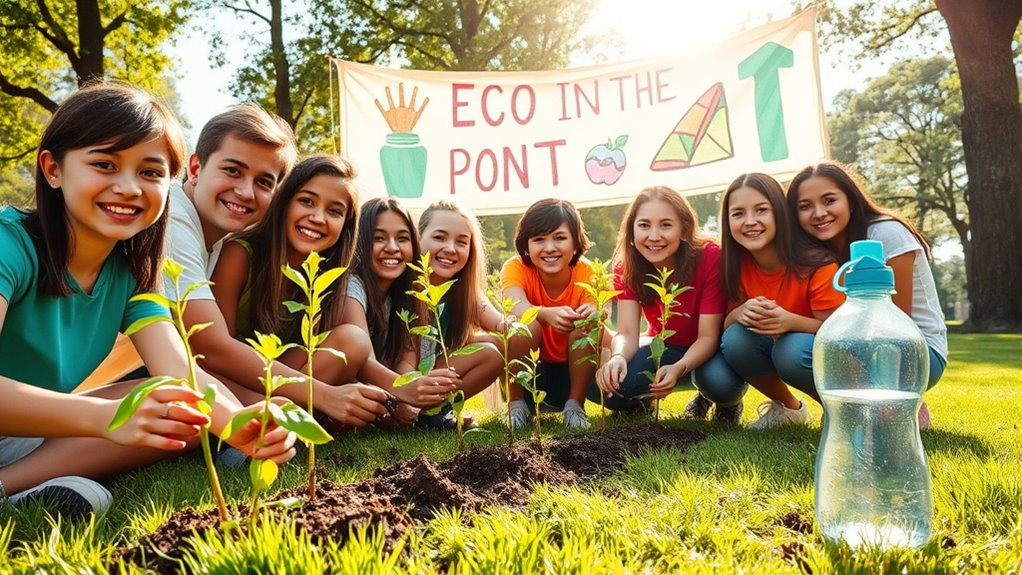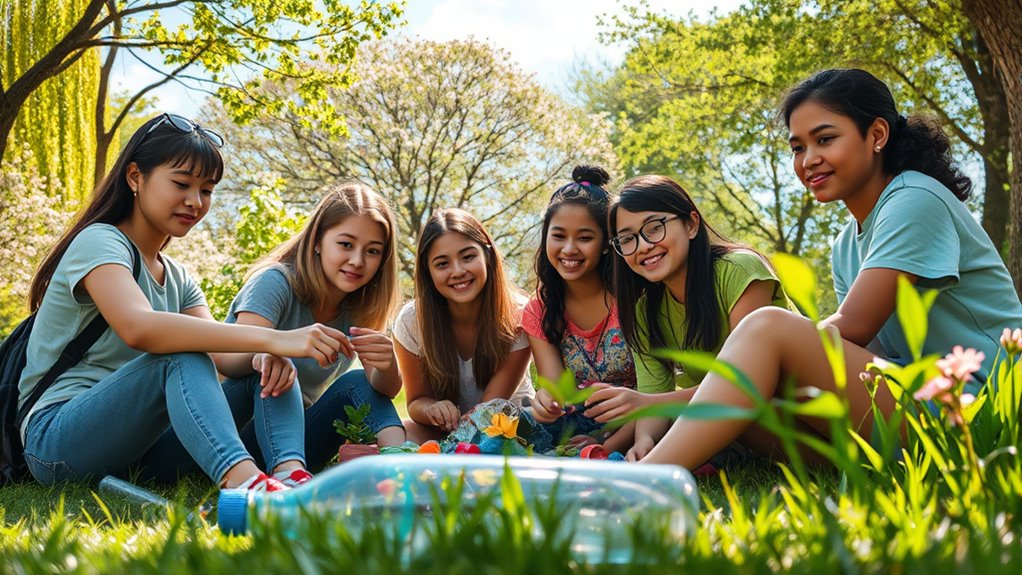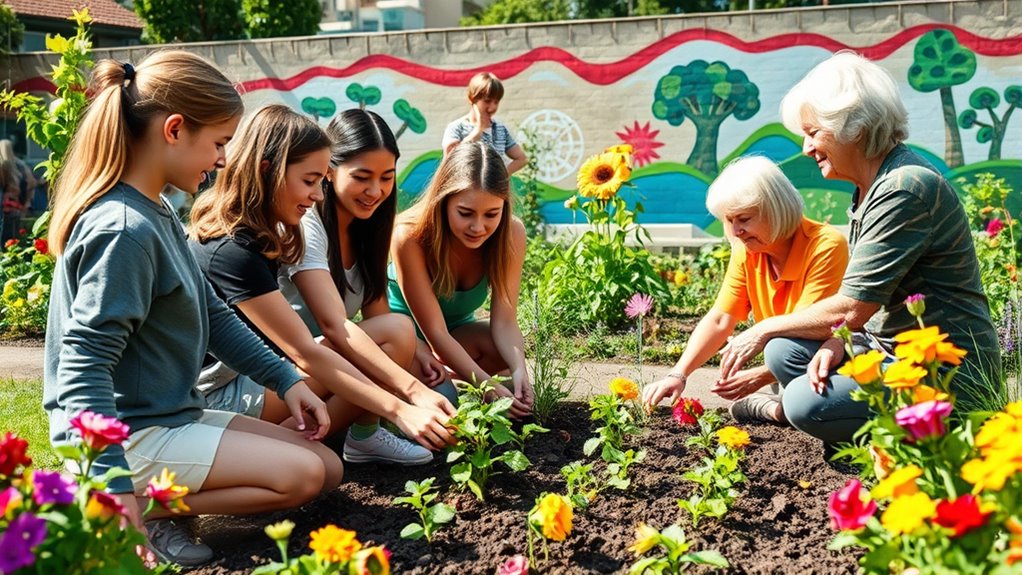Engaging teens in sustainability through environmental activism is essential for a healthier future. You’ll find that youth-led movements, like Fridays For Future, are gaining momentum, driven by social media. Teens often experience climate anxiety, feeling overwhelmed by the challenges ahead. By participating in hands-on eco-projects and connecting across generations, you can foster a strong sense of responsibility and empowerment. This journey into activism not only builds resilience but also opens the door to innovative solutions and community support.
Key Takeaways
- Foster youth-led initiatives like Fridays For Future to empower teens in advocating for sustainable policies and climate action.
- Utilize social media platforms to connect and mobilize teens, promoting engagement through relevant hashtags and user-generated content.
- Implement hands-on educational projects, such as school gardens and recycling competitions, to instill environmental responsibility among students.
- Encourage intergenerational collaborations that combine the wisdom of older generations with the innovation of youth in sustainability efforts.
- Address climate anxiety by providing support resources and fostering a community where teens can share their concerns and solutions.
The Rise of Youth Environmental Activism

As young people increasingly recognize the urgency of climate change, youth-led environmental activism has surged to the forefront of global movements. You’ve likely seen the impact of groups like Fridays For Future and the Sunrise Movement, where young activists take charge in demanding change. Social media plays a significant role in amplifying their voices, allowing you to connect with millions participating in climate strikes worldwide. Figures like Greta Thunberg inspire you to act, showcasing how one person can spark a movement. Activism encompasses your involvement in these initiatives isn’t just about protesting; it’s about influencing policy discussions and pushing for systemic changes. Together, you and your peers are creating a powerful force for environmental justice, shaping a sustainable future for generations to come.
Understanding Climate Anxiety Among Teens

The surge in youth-led environmental activism reflects a growing awareness of climate issues, but it also gives rise to a troubling phenomenon: climate anxiety among teens.
Around 37% of you feel anxious about climate change, with many fearing its impacts. This worry influences your decisions, like where you want to live or study.
Most of you experience feelings of helplessness, with only 17% expressing optimism about the future. Contributing factors include extreme weather events, relentless media coverage, and a lack of government action, which intensifies your fears. Furthermore, the emotional toll of climate anxiety not only impacts your mental health but can limit your ability to plan for the future. Addressing these feelings is vital for your well-being and engagement in activism.
The Role of Social Media in Activism

While social media has transformed how teens engage with environmental activism, it’s also reshaped the landscape of communication around sustainability. Platforms like Instagram and TikTok enable you to mobilize quickly, connecting with others regardless of location. Additionally, sharing cultural content related to activism can enhance community engagement and inspire collective action.
Movements such as #FridaysForFuture show how hashtags can unite global protests, amplifying your voice. User-generated content makes messages relatable, enhancing engagement and awareness. Emotional storytelling and eye-catching visuals foster empathy, inspiring you to act. Additionally, be aware that restrictions on URL access may affect the way information is shared and gathered online. Furthermore, understanding art theory can deepen your appreciation for the creative expressions within the movement.
Social media also provides actionable steps, encouraging sustainable choices in your daily life. However, be mindful of challenges like misleading information and slacktivism, which can dilute your impact.
Ultimately, social media is a powerful tool for fostering community and driving meaningful change in environmental activism.
Educational Initiatives to Foster Environmental Responsibility

Social media has sparked a wave of awareness and activism among teens, but the foundation of long-lasting environmental responsibility lies in education.
Schools are stepping up by implementing eco-friendly campus upgrades and energy conservation programs that empower you to make a difference. Hands-on projects, like school gardens and composting systems, allow you to engage directly with sustainability. Municipal solid waste production is projected to increase by 70% by 2050, highlighting the urgent need for responsible waste management practices.
Recycling competitions promote responsible waste disposal while green infrastructures serve as living laboratories. Integrating environmental education through interdisciplinary approaches and project-based learning equips you with essential skills to tackle global challenges.
Field trips to nature reserves connect you with the environment, while community engagement fosters civic responsibility. Together, these educational initiatives inspire you to become a proactive agent of change for a sustainable future.
Building Intergenerational Collaborations for Sustainability

Intergenerational collaborations for sustainability harness the unique strengths of both older and younger generations, creating a powerful alliance in the fight against environmental challenges.
Community gardens exemplify this, where older generations share traditional gardening techniques while younger participants introduce modern technologies.
Mentorship programs connect experienced professionals with youth, fostering skill development. Climate action groups unite all ages to advocate for policies and engage in projects.
However, it’s essential to address barriers like generational gaps and resource limitations. Organizing workshops, storytelling sessions, and community forums can bridge these divides.
Frequently Asked Questions
How Can Teens Start Their Own Environmental Initiatives?
If you want to start your own environmental initiatives, begin by identifying a local issue that resonates with you.
Gather a group of friends and brainstorm ideas. You could establish a community garden, organize clean-up events, or create a social media campaign.
Connect with local organizations for support and resources. Don’t forget to promote your efforts online and engage your peers.
Collaborate, innovate, and inspire others to join your cause for a sustainable future!
What Role Do Parents Play in Youth Activism?
Parents play a vital role in youth activism by modeling sustainable practices at home and engaging in community initiatives.
By discussing environmental issues and supporting their children’s interests, you empower them to take action. Your involvement in local events can inspire their commitment and show the importance of collective efforts.
Encouraging critical thinking and providing resources helps them strategize effectively, fostering a sense of responsibility and leadership in tackling environmental challenges.
Are There Scholarships for Youth Involved in Environmental Work?
If you’re passionate about the environment, you’re in luck! There are several scholarships available for youth involved in environmental work.
The Brower Youth Awards, for instance, rewards young leaders with $3,000. You can also check out the David E. Lumley Scholarship, which offers $1,000 for research.
Additionally, the Action for Nature Award recognizes your projects with $500. Immerse yourself and seize these opportunities to support your environmental journey!
How Can Schools Incorporate More Environmental Education?
You can incorporate more environmental education in schools by organizing outdoor learning activities like nature walks and field trips.
Develop an engaging curriculum that focuses on climate change and conservation, connecting these topics to other subjects.
Collaborate with local environmental organizations for resources and expertise.
Promote awareness campaigns that encourage sustainable practices among students.
Finally, create project-based learning opportunities that allow students to tackle local environmental challenges, fostering a sense of responsibility and ownership.
What Are Some Successful Youth-Led Environmental Projects Worldwide?
You’ll find numerous successful youth-led environmental projects worldwide.
For instance, the Fridays for Future movement empowers students to strike for climate action.
The Ocean Cleanup engages young innovators to tackle ocean plastic, while Plant-for-the-Planet trains youth in forest restoration.
In urban areas, community gardens foster sustainable agriculture and environmental education.
These initiatives not only raise awareness but also inspire young people to take meaningful action for a sustainable future.
Conclusion
In a world where teens hold the power to save the planet, your engagement can spark a revolution! Imagine their voices echoing in every corner of the globe, demanding change like modern-day superheroes. By harnessing social media, participating in initiatives, and collaborating across generations, you can release a tidal wave of sustainability. So, plunge in and ignite that passion—because when teens unite for the environment, they’re not just making noise; they’re creating a symphony of change that’ll resonate for centuries!









